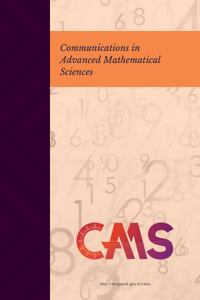On Growth and Approximation of Generalized Biaxially Symmetric Potentials on Parabolic-Convex Sets
On Growth and Approximation of Generalized Biaxially Symmetric Potentials on Parabolic-Convex Sets
Parabolic-convex set, Index-q, q-order, Lower q-order Generalized bi-axially symmetric potentials and elliptic partial differential equation,
___
- [1] P. A. McCoy, Approximation of generalized biaxially symmetric potentials on certain domains, J. Math. Anal. Appl., 82 (1981), 463-469.
- [2] R. P. Gilbert, Integral operator methods in biaxially symmetric potential theory, Contrib. Diff. Eqns., 2 (1963), 441-456.
- [3] G. S. Srivastava, On the growth and polynomial approximation of generalized biaxisymmetric potentials, Soochow J. Math., 23(4) (1997), 345-358.
- [4] P. A. McCoy, Best Lp-approximation of generalized biaxisymmetric potentials, Proc. Amer. Math. Soc., 79 (1980), 435-440.
- [5] D. Kumar, A. Basu, Growth and approximation of generalized biaxially symmetric potentials, J. Math. Res. Appl., 35(6) (2015), 613-624.
- [6] D. Kumar, P. Bishnoi, On the refined measures of growth of generalized biaxially symmetric potentials having index-q, Fasciculi Matematici, 48 (2012), 61-72.
- [7] M. Harfaoui, Generalized order and best approximation of entire function in Lp-norm, Intern. J. Math. Math. Sci., 2010 (2010), 1-15.
- [8] D. Kumar, Growth and approximation of solutions to a class of certain linear partial differential equations in RN, Math. Slovaca, 64(1) (2014), 139-154.
- [9] M. E. Kadiri, M. Harfaoui, Best polynomial approximation in Lp-norm and (p;q)-growth of entire functions, Abstr. Appl. Anal., 2013 (2013), 1-9.
- [10] H. S. Kasana, D. Kumar, Approximation of generalized bi-axially symmetric potentials with fast rates of growth, Acta Math. Sinica (Wuhan-China), 15(4) (1995), 458-467.
- [11] H. S. Kasana, D. Kumar, The Lp-approximation of generalized biaxisymmetric potentials, Int. J. Diff. Eqns. Appl., 9(2) (2004), 127-142.
- [12] H. S. Kasana, D. Kumar, Lp-approximation of generalized bi-axially symmetric potentials over Caratheodory domains, Math. Slovaca, 55(5) (2005), 563-572.
- [13] G. P. Kapoor, A. Nautiyal, Growth and approximation of generalized bi-axially symmetric potentials, Indian J. Pure Appl. Math., 19 (1980), 464-476.
- [14] P. A. McCoy, Polynomial approximation of generalized biaxisymmetric potentials, J. Approx. Theory, 25(2) (1979), 153-168.
- [15] D. Sato, On the rate of growth of entire functions of fast growth, Bull. Amer. Math. Soc., 69 (1963), 411-414.
- [16] J. M. Whittaker, The lower order of integral functions, J. London Math. Soc., 8 (1973), 20-27.
- [17] A. Gray, S. M. Shah, Holomorphic functions with gap power series, Math. Z., 86 (1965), 375-394.
- [18] O. P. Juneja, G.P. Kapoor, On the lower order of entire functions, J. London Math. Soc., 5(2) (1972), 310-312.
- [19] S. N. Bernstein, Lecons sur les proprietes extremales et la meilleure approximation des fonctions analytiques d’une variable reille, Gauthier-Villars, Paris, 1926.
- [20] A. Giroux, Approximation of entire functions over bounded domains, J. Approx. Theory, 28 (1980), 45-53.
- [21] O. P. Juneja, On the coefficients of an entire series, J. Anal. Math., 24 (1971), 395-401.
- ISSN: 2651-4001
- Yayın Aralığı: Yılda 4 Sayı
- Başlangıç: 2018
- Yayıncı: Emrah Evren KARA
On the Periodic Solutions of Some Systems of Difference Equations
Norm-Attainability and Range-Kernel Orthogonality of Elementary Operators
On Growth and Approximation of Generalized Biaxially Symmetric Potentials on Parabolic-Convex Sets
L-Fuzzy Invariant Metric Space
Mixed-Type Functional Differential Equations: A $C_{0}$-Semigroup Approach
Luis Gerardo MÁRMOL, Carmen Judith VANEGAS
Modifications of Strongly Nodec Spaces
On Bicomplex Pell and Pell-Lucas Numbers
Fixed Point Sets of Multivalued Contractions and Stability Analysis
